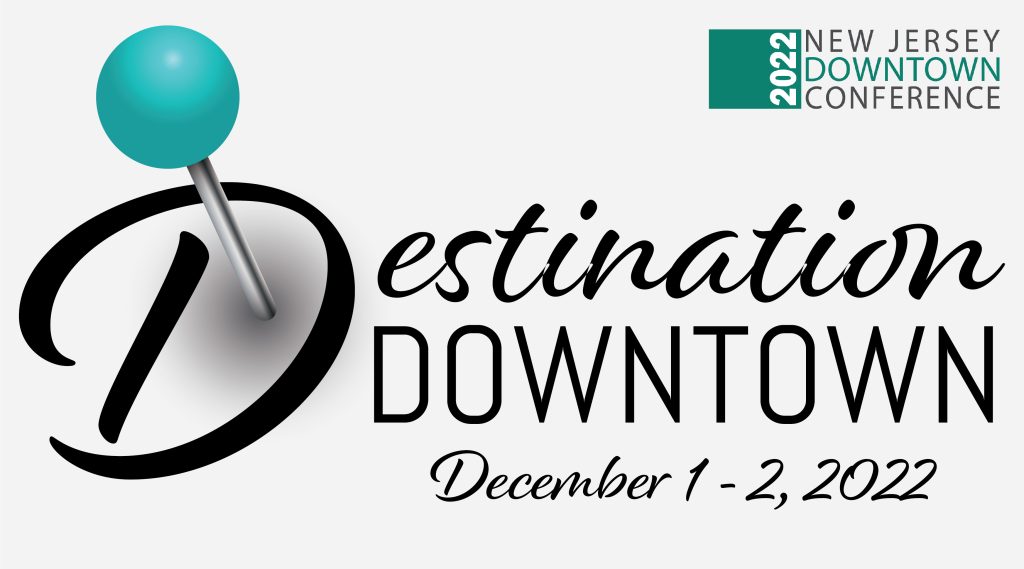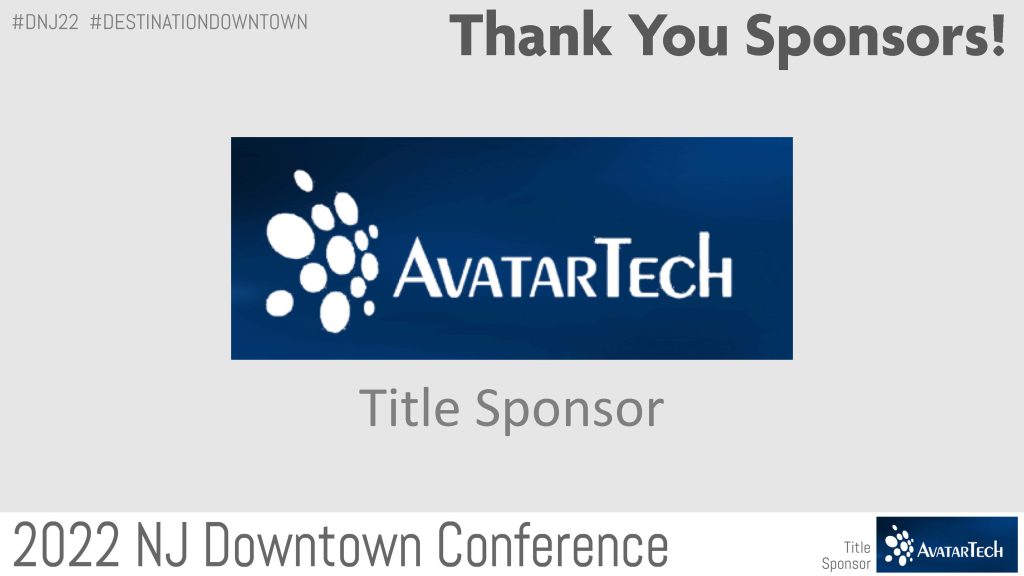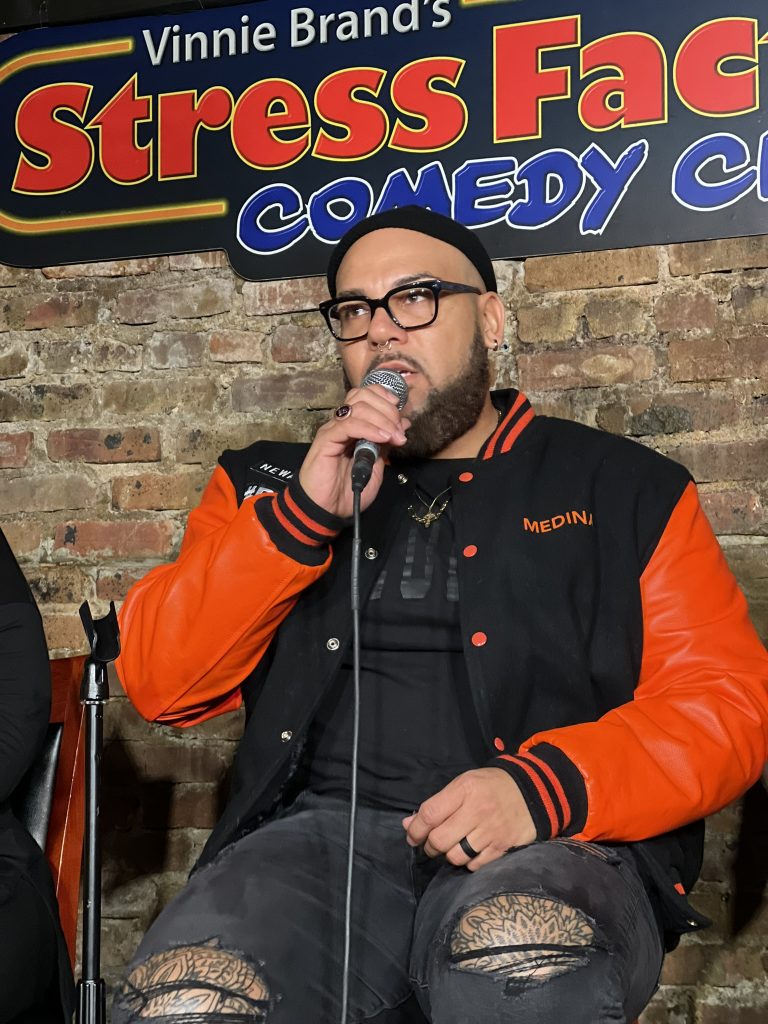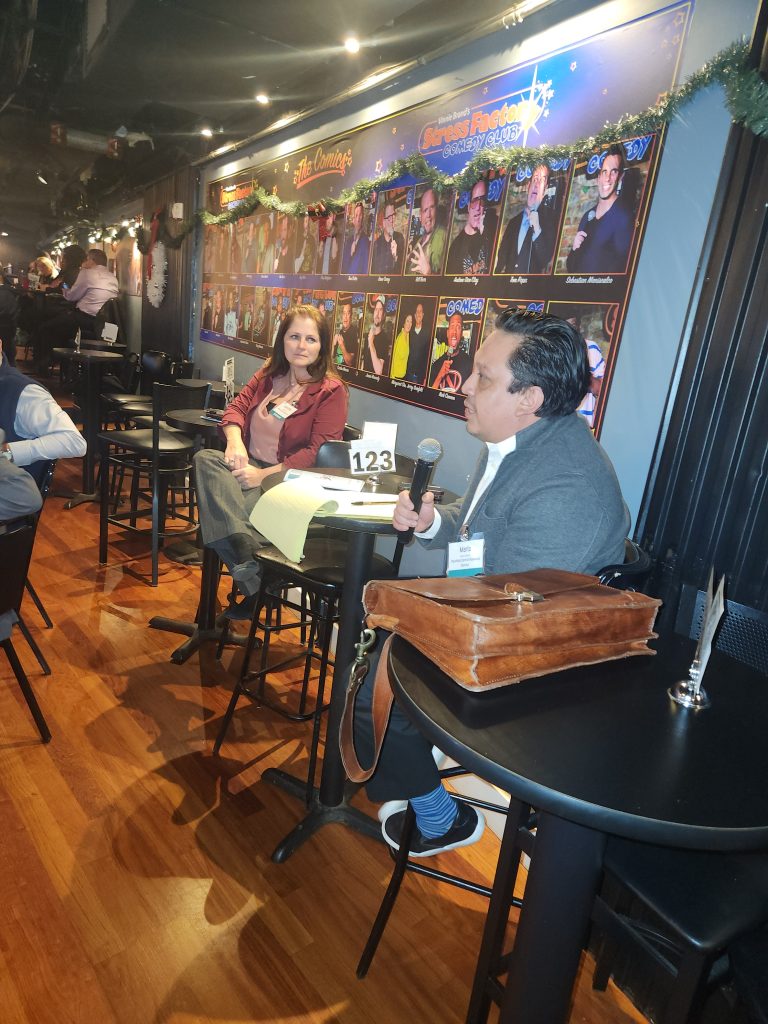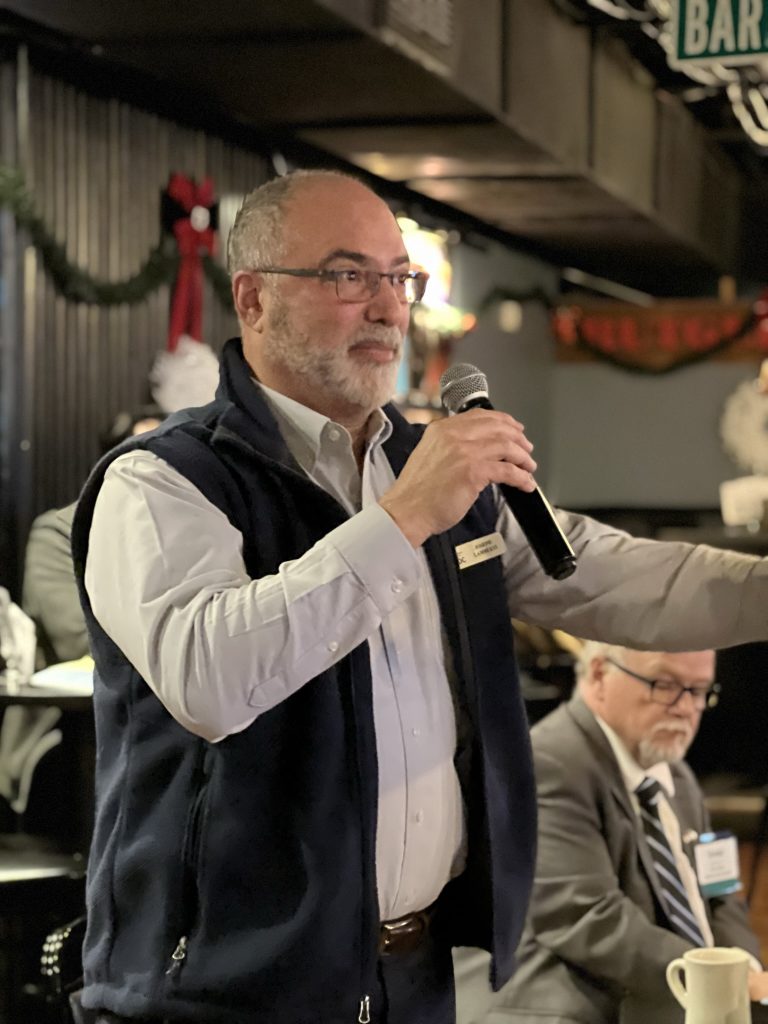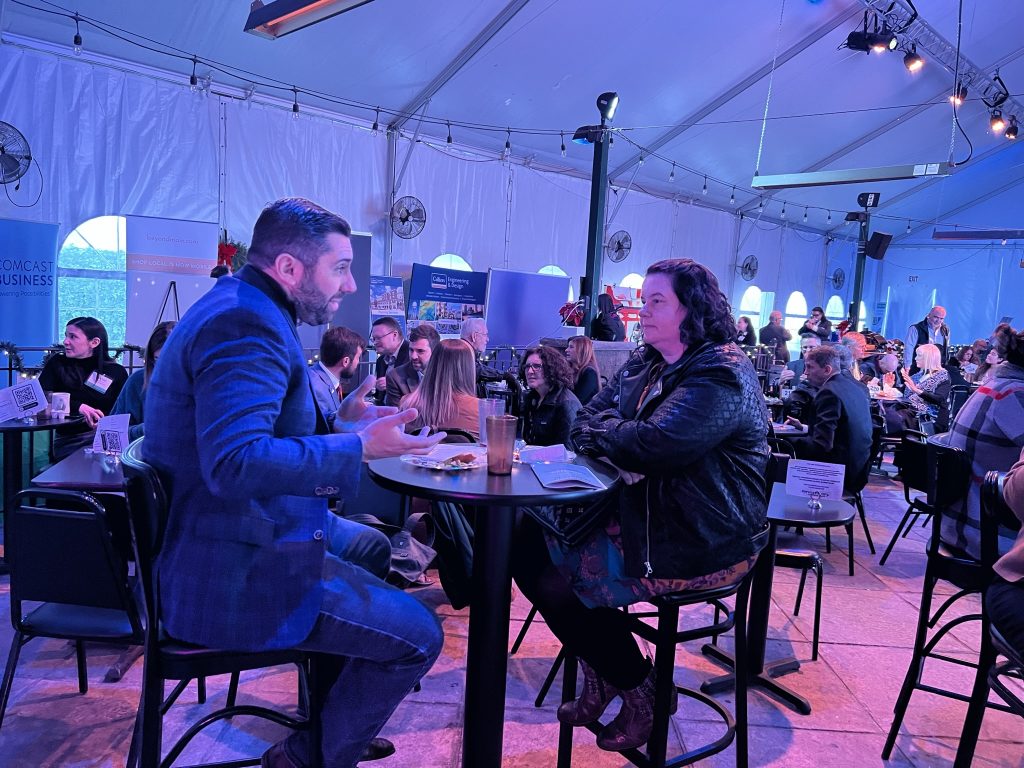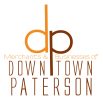Annual NJ Downtown Conference Reveals How Downtowns Can Become Destinations
Rebecca Hersh
Write Way Media
Cailean Kok
Downtown New Jersey
December 14, 2022
Statewide non-profit organization hosted industry leaders in real estate and downtown management
2022 NJ DOWNTOWN CONFERENCE IN THE NEWS:
What a NJ Downtown Really Needs to Be Special & Thrive – NJ 101.5
TAPinto CEO Michael Shapiro Participates in Downtown New Jersey Panel – TAPinto
Downtown New Jersey’s annual conference and New Jersey’s premiere economic development event, returned in person with a hybrid conference on December 1 and 2, 2022, with sessions live and in person at the Stress Factory in downtown New Brunswick, as well as live online sessions accessed through their website. The “Destination Downtown” conference featured insights on how communities could put their best foot forward to bring vitality, investment, and creativity to their downtowns.
Throughout the two days and multiple panels and discussions, four key themes and actions came through as key to making your downtown a destination:
- Partnerships: Resources are not infinite, so getting things done requires stakeholders to join forces and address things from multiple angles. When we partner, we create a platform for innovation, inclusion, and raising the value of our downtowns.
- Inclusion: If we say we are committed to diversity and inclusion, we need to be intentional in breaking down barriers so that participation is worthwhile and that there is room for creativity to thrive.
- Policy: While a balance is needed to protect the interests of diverse stakeholders, policy should be designed to support businesses, not drive them away. Legislative powers can support our downtowns in becoming a place for business, creativity, and tourism.
- Curation: Creating great places takes a curated approach to providing a unique experience. It’s not just about the business mix, but intentional actions around aesthetic, programming, and promotions that create a sense if inclusivity.
Day 1: Live & In-person in New Brunswick
The first day of the conference featured local officials, economic development and real estate professionals, and business owners who emphasized the importance of partnerships to help downtowns and their businesses thrive.
Bob Zuckerman, President of Downtown New Jersey (DNJ), kicked off the conference with a year in review for the organization and downtown revitalization, and introduced the panel of local officials to discuss the variety of ways towns can cultivate different types of partnerships to maximize downtown success. He also expressed gratitude to the 2022 NJ Downtown Conference sponsors whose generosity not only made this event possible, but supports our educational, advocacy and programming throughout the year.
Plenary Discussion: Building Partnerships
Jef Buehler, leader of the New Jersey Neighborhood Preservation Program and DNJ board member, moderated a discussion among local officials about building partnerships between municipal government and its downtown. He kicked off the session with a video about communities doing just that through the NJ Department of Community Affair’s (NJDCA) Neighborhood Preservation Program (NPP).

“Nobody has infinite time, talent, or treasure,” he began. “By being able to leverage the time, talent, and treasure across public, private sector, BID [sic Business Improvement District] organizations, individual property owners, residents, we can raise all the value of our downtowns that much better and more quickly.” He stressed the importance of partnerships, noting the different roles and powers different partners have — the municipal government, the local BID, a local nonprofit, a volunteer team — and how a robust partnership means problems can be addressed from multiple angles.
Sheena Collum, President of the Township of South Orange Village, highlighted the wide range of activities happening in South Orange — all the result of a variety of partnerships between the municipality, the NPP staff, the local BID, neighborhood groups, arts organizations, and more — including redevelopment projects, new housing units, events, business incubator projects, and a focus on revitalizing the municipality’s secondary commercial corridors. She noted that the key to successful projects and partnerships is to engage all the stakeholders early and often, flood the zone with good information so naysayers don’t have the chance to dominate the narrative, and to maximize partnerships from every facet of the community to create an army of ambassadors for an initiative.
The Mayor of the Borough of Flemington, Betsy Driver, discussed Flemington’s efforts to redevelop a number of areas of town and to recruit businesses and market the town. Flemington used its recent NPP grant as an opportunity to put together a diverse stakeholder group to ensure the entire town was represented and had a voice in the process. When asked what made these partnerships work, she stressed the importance of communicating with and carefully listening to all the stakeholders, and not being afraid to take bold action if the stakeholders support it.
Noelia Cologne, BID Director from the City Perth Amboy, noted that partnerships between the Perth Amboy BID, the municipality, and local businesses was what enabled the community to pull together during the pandemic and support the local businesses with a communal website, walking tours, and a gift card program. Another partnership, between the BID, the municipality, and Together North Jersey, is working to create a new green space in a neglected stretch of town. “Compromise and alignment within organizations and governing bodies is the most important thing,” she said.
Panel Discussion: Downtown Hospitality
Hospitality and entertainment businesses have always been major drivers of economic activity, but how should municipalities nurture these businesses while also addressing the needs of residents and other businesses? This often-delicate balance was this panel’s focus, led by moderator Emily Manz of Invest Newark and a DNJ board member, who started the discussion by pointing out the critical importance of these industries for our downtowns.

“Our goal is to keep New Brunswick safe, clean, convenient, and fun,” said restaurateur and New Brunswick City Center chair Douglas Schneider. “We are lucky that in New Brunswick, we have ‘natural resources’ — our courthouses, theaters, J&J, Rutgers, the hospitals, two full-service hotels. It’s our duty to be hospitable to them.” Paul Muir, president of the Guild of Clinton, noted that towns like Clinton don’t have the same resources as a city like New Brunswick, so the local government and business improvement district has to create hospitality experiences themselves. “We have to work hard to drag people out, we have to create magical experiences.”
Panelists discussed the importance of supporting business owners in the hospitality sector and always making sure they have a voice and a seat at the table, to remember that lack of small business participation in local initiatives and programs does not necessarily mean lack of interest, and to make sure that any business participation is rewarding and worthwhile for these usually time-strapped business owners. Ensuring that the community is engaged in supporting local businesses, and vice versa, is critical and can yield powerful results; for example, Shoshanna Page, Senior Policy Advisor and Communications Strategist from Mayor Ras J. Baraka’s Office in the City of Newark, noted that Newark businesses were protected from vandalism during the George Floyd protests because of the groundwork that built the relationships between the community and the local merchants.
State and local policy changes are also critical to supporting small business owners. The City of Newark, for example, is advocating for liquor license reform that would make inactive licenses expire and be turned back over to the municipality after five years, as well as advocating for more state funding for arts organizations and residency requirements for police and firemen. Asbury Park has eliminated parking standards, instead letting businesses pay into a parking fund dedicated to the building of a future garage.
Marketing and events were discussed as crucial elements to get people downtown, and into the downtown businesses. New Brunswick’s newbrunswick.com website is used as an aggregator of everything going on in the city, including local business activity, and is one of the most important tools in the city’s toolbox for getting the word out about local business activity.
Finally, panelists discussed the delicate balance that must be struck between hospitality businesses and resident quality of life. Michele Alonso, Director of Planning and Redevelopment for the City of Asbury Park, noted that Asbury Park requires any business with a performing arts element to include noise mitigation as part of the business’s permitting process. The city also requires businesses with a record of nuisance calls to hire security guards as part of their liquor license renewal process, to ensure patrons don’t disturb the peace. Making sure residents are listened to and involved in the process is a critical way to avoid conflicts.
Panel Discussion: The Office Conundrum
The pandemic led to a dramatic increase in the numbers of people who work from home, either full time or part time. This trend has caused a great deal of uncertainty, both in the office real estate market and to the small, local businesses that serve office workers. Session moderator Vanessa Quijano, Director of Communication for NJ Community Capital and DNJ Vice President, kicked off the panel with an overview of how much downtowns have emptied out during the pandemic. “Even now, 42% of workers now work from home full-time. Others only go in a few days a week,” she noted.
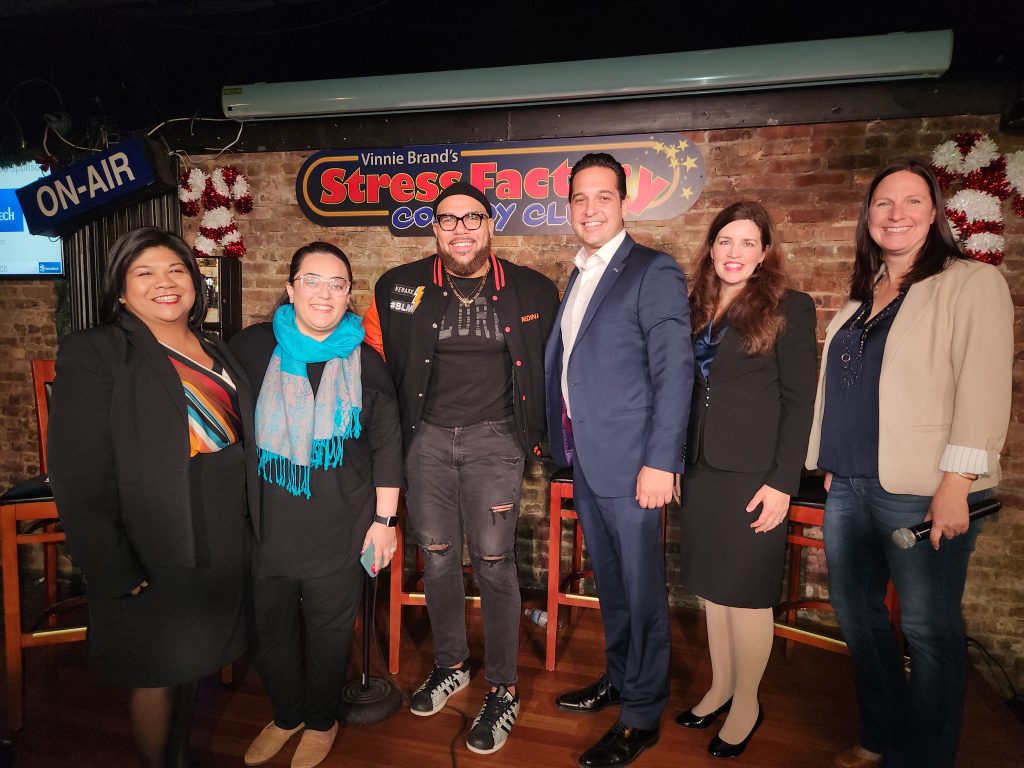
Citi Medina, Founder of =Space, noted that it’s been a tough adjustment to realize that downtown commercial activity was never going to go back to the way it was before. “How do we deal with this new people-less existence?” he asked. “We’ve had to find nuggets of programming that cluster people together and activate ourselves in unique ways to bring clusters of people together.”
Peter Bronsnick, Executive Managing Director and Managing Principal of New Jersey Cushman & Wakefield, expressed grave concerns about these trends. “What we’re doing here is dangerous to our downtowns, dangerous to our communities. While we can be just as productive at home, we can’t possibly be just as innovative. Things like culture and mentorship are not the same.” He noted that while it is a bright spot that people do still want the amenities that downtowns offer, we remain in danger of watching our urban centers and downtowns really suffer long-term if people don’t populate them every day.
Panelists then discussed ways to populate downtowns that aren’t as reliant on office space occupancy. Megan Hunscher, President and CEO of the Morris County Chamber of Commerce, noted that events are a great way to bring people into downtowns. “There are ways to work with local governments and BIDs and businesses to create meaningful experiences,” she said, and she added that local BIDs and chambers of commerce are great resources for ideas, grants, partnerships, and other resources to make events happen. Mr. Medina discussed initiatives that supported small businesses in his community, including the creation of an online shopping portal, merchandise pickup locations, and other ways to sell and deliver products. Sejal Sharma, Director of Business Development from Robert Wood Johnson University Hospital (RWUJ) – Somerset, stressed the importance of creative community partnerships between businesses in the community, and highlighted RWJUH -Somerset’s partnership with the Downtown Somerville Alliance on a variety of projects involving local businesses, including donating masks and sanitizer to businesses and creating napkins with health tips printed on them so restaurants could put the napkins into takeout orders.
Day 2: Live Online
The second day of the conference brought together local practitioners along with professionals in the arts, film, and media to discuss how creative programming and promotion can be a catalyst for economic development downtown.
Panel Discussion: Arts and Culture as a Catalyst for Economic Investment and Vitality
Local economic vitality is connected to the activities of the arts and culture sector in many ways. Session moderator Natalie Pineiro, Executive Director for Downtown Somerville and a DNJ board member, kicked off the panel highlighting the need to communicate the linkage between the investment in arts and culture being an investment in your community. She reminded our audience that as many communities around New Jersey are engaging in redevelopment efforts, there are a diversity of opportunities to negotiate with developers to include public art as a community and economic benefit.

Anne Marie Miller, Director of Advocacy & Public Policy for ArtPride New Jersey pointed to Arts & Economic Prosperity 5, which revealed that the arts industry in New Jersey generates $519.8 million in economic activity annually. Applying this to their advocacy work during the pandemic, ArtPride New Jersey was able to successfully advocate for approximately $160 million dollars in funds for the public arts. Lea Weingarten, Principal of Weingarten Art Group pointed to exhibitions like Discovery Green in Downtown Houston, which ranging from just 10 days to 3 months-long attracted anywhere from 30 thousand to 100 thousand for any one installation. She noted that not only do these installations support the artist, they also support a whole industry of artists and impact surrounding local businesses. Daryl Stewart, Founder & CEO of Daryl Stewart Productions, curated a series of theatrical performances to attract people to Downtown Newark, and as part of this work, he worked with local restaurants to help drive people to them with incentives.
While public art has historically been rooted in permanent installations, Weingarten has found rotating installations to be more effective in creating increased opportunities for artists and their supporting industries, as well as creating a sense of excitement that drives more publicity and visitors, ultimately positively impacting the surrounding local businesses and overall financial health of the community. Leon Rainbow stresses the importance of having permanent installations as a type of icon or landmark, he also agrees that rotating installations are important for better engaging with the community.
Panelists discussed how to bring these art programs to life. The panelists agreed that you need to start small and build momentum. Miller pointed to small grants from New Jersey’s Cultural Heritage Commission for getting started. Pineiro suggested that overtime, a couple of small initiatives can create momentum through increased interest and support. Communities can quantify the impact of these programs by tracking the number of visitors and the sales of local businesses to understand how visitors spend their money. Once real estate developers and local businesses see that arts programs bring people downtown spending money, you will start to build a self-sustaining program.
The discussion concluded with ideas for how communities can better support artists. Artist Leon Rainbow said that the administrative work can be burdensome, and artists should also be compensated for time spent navigating local regulations. On the municipal side, communities can work to reshape or remove ordinances that act as barriers to having a robust public arts program. Communities can also engage a curator who can help artists navigate permits, contracts, and insurance, as well as engage the community to build support from the beginning. As Stewart pointed out, if our communities are going to say that they are committed to diversity and inclusion, then they must be willing to do the work to break down barriers. As part of her work, Weingarten provides professional photography and videography, which helps the artists build their portfolio and creates content to help promote and grow the program itself. Other ideas included offering access to housing, workspace, and social media platforms to artists while they are working in your community.
Panel Discussion: Setting the Scene for Local Film Production
Long before Hollywood was Hollywood, the film industry was booming in New Jersey – the first film projector, studio, and drive-in theatre opened in New Jersey. Showbiz has returned to New Jersey thanks to an incredible range of positive factors, including locations, production infrastructure, and film friendly logistics. This session focused on what bringing film production back to the Garden State means for main streets and about the opportunities to grow an ecosystem involving the film, television, and digital media industry.

Elizabeth Parchment, Director of Marketing and Chief Diversity Officer of the NJ Motion Picture + TV Commission shared how 2021 was a record-breaking year with $501 million in film and television revenue, representing a 647% increase since 2018. Before 2018, New Jersey had a hard time competing with other states, as well as Canada, that offered lucrative incentives to filmmakers to work in their communities. This changed in 2018 when the Garden State Film and Digital Media Jobs Act was signed into law by Governor Phil Murphy. The Act offers a film and digital media tax credit program to incentivize filming in New Jersey.
Joe Marra, Production Coordinator of the NJ Motion Picture + TV highlighted the public facing database used by film commissions around the world. New Jersey currently has 3,400 locations and over 50,000 location photos on the database, however, many of New Jersey’s 565 municipalities still do not have any location photos. This is where the new program, Film Ready New Jersey comes in. The program will be rolling out in March 2023 to educate municipalities on production needs and work to set up municipalities to market their communities as filming destinations.
Municipalities can put ordinances or a code of conduct in place for film productions, however, municipalities should be careful about overregulating – the focus should be on attracting and retaining filmmakers. The Township of Cranford has a code of conduct that has been in place for decades that lays out the ground rules for film productions when working in their community. Kathleen Miller Prunty, Mayor of the Township of Cranford, explained that they pride themselves in being open to business and that film production is just like any other business venture, you must understand the needs of both sides and form a partnership to make it work. Al Kahwaty, Co-Chair of the Passaic County Film Commission and a Council man in little Falls, re-wrote the municipality’s ordinance to make it easier for film production to happen. He explained that “being a cooperative town doesn’t mean you are going to be taken advantage of… it puts you on a list of places where people will want to work.”
Panelists concluded with thoughts about how communities can make it so that film productions want to come to your town. Mayor Prunty made an argument for designating a point person for film productions so that both sides have someone that they can rely on. Kahwaty reminded us that film production is a very complicated job and that municipalities need to make their job as easy as possible so that they will want to come back. Film productions boost the downtown economy in ways beyond permit revenues, they pay residents and local businesses that are inconvenienced, they pay location fees, they source from local services, and they continue to drive tourism long after production has wrapped up.
Panel Discussion: How to Make Your Downtown Famous
With the changing local media landscape, it’s not always easy to figure out how to let the world know about your town. This session focused on how to navigate the various components of effective public relations initiatives to promote your town’s retail, events, and economic development initiatives.

“Successful branding is all about communicating your stories,” noted Susan Adelizzi-Schmidt, President of Suasion Communications and a DNJ Board Member, as she introduced the panel. She stressed that getting noticed by the media and general public is heavily dependent on a number of things: good graphic design and branding; regularly updating and posting on websites and all the most popular social media apps (Facebook, Instagram, YouTube, Twitter, LinkedIn, and TikTok); creating interesting and experiential events; always showcasing town pride with, among other things, branded merchandise; electronic newsletter blasts; seeking out local awards and competitions that can bring a spotlight to your community; and public relations campaigns that include regular press releases, billboards, and digital marketing efforts. “It’s all about relationships,” she added. Take the time to get to know people. It will pay off down the line.”
Michael Shapiro, CEO of TAPinto, and Jennifer Tripucka, Founder, The Local Girl Media Group, discussed how their hyperlocal news and media outlets have picked up some of the slack as traditional local newspapers have been disappearing. “There are hundreds of municipalities without a local newspaper,” Mr. Shapiro said. “It’s really important to have vibrant local news for democracy’s sake.”
Both discussed ways to pique the interest of local media. Ms. Tripucka noted, “We want something that’s universally exciting and has the potential to bring the community together, something new and unique. Businesses that are having an experience for customers that’s really unique is what stands out to our readers.” Mr. Shapiro added that sharing events on TAPinto’s community calendar is a good way to reach people.
Robin Lapidus, Executive Director of the Flemington BID, noted that towns need to cultivate influencers in local residents and business owners, make sure various constituencies take photographs around town and post them on social media pages, to “help places speak for themselves” and to find what is universally loved in your town and layer onto it. “I’ve had store owners call me crying because they weren’t mentioned in some story they thought they should have been mentioned in. It is really incumbent on the BID director to convey to the merchants that this isn’t a magical process. Reporters only find whatever is out there; shops have to keep current photos and news on all the social media platforms. The ones that create the most content are the ones that get noticed the most.”
In the absence of enough local newspapers, and acknowledging that some people still do not regularly use the internet, all the panelists stressed using any and all tools available. Municipal social media pages, municipal newsletter blasts, billboards, paid advertising in the remaining local newspapers, encouraging individual businesses to have a robust social media presence, radio ads, local access TV channels, and posters and flyers were all tactics suggested by the panelists.
Ultimately, consistency and maintaining a steady stream of information in every available format is what the panelists agreed would eventually pay off in local media attention and general public attention. “If you’re only sending out one press release per year, the chances of getting noticed are slim,” said Ms. Adelizzi-Schmidt. “If I had one tip, it would be to keep up the consistency of messaging.”
Missed a session or the whole conference?
All of the videos, PowerPoints, and referenced resources from the conference are available to view on the conference website. Registered conference attendees can use their existing login credentials to access the videos and materials.
Didn’t register for the conference? You can still register at a reduced rate to gain access to recordings of conference sessions. More info>

